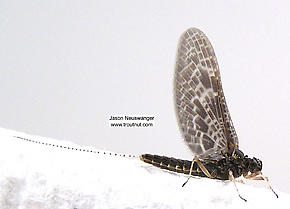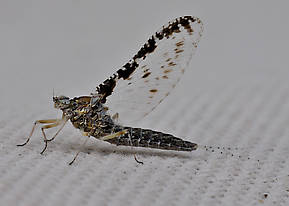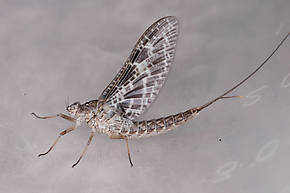Blog & Latest Updates
Fly Fishing Articles
Insects by Common Name


Mayfly Genus Callibaetis (Speckled Spinners)
Taxonomic Navigation -?-
Kingdom
Animalia (Animals)
» Phylum
Arthropoda (Arthropods)
» Class
Insecta (Insects)
» Order
Ephemeroptera (Mayflies)
» Family
Baetidae (Blue-Winged Olives)
» Genus Callibaetis (Speckled Spinners)
6 species aren't included.
Common Names
The most important are the sub-species Callibaetis ferrugineus ferrugineus in the East and Midwest and Callibaetis ferrugineus hageni in the West. It is in the West however, where this genus achieves its densest populations and most significant hatches. Other important western species also happen to be at both sides of the size scale. The outsized Callibaetis californicus can produce excellent hatches. The diminutive Callibaetis pictus can also be locally prolific, especially at higher elevations.
The duns are easily recognized by their speckled bodies and distinctive wings usually featuring a dark background overlaid with white veins. Female spinners are also easy to recognize with their clear wing's leading edges marked with dark blotches -- see the pictures.
Where & When
Time Of Year (?): May through October; best in Summer
Preferred Waters: Mostly lakes and ponds; sometimes slow rivers
Callibaetis species usually produce two and sometimes up to three broods in a single season. Their peak times vary widely by location.Preferred Waters: Mostly lakes and ponds; sometimes slow rivers
Hatching Behavior
Callibaetis duns emerge on the surface. They can take flight quickly or ride the water's surface for a lengthy period, depending on circumstances. Knopp and Cormier write in Mayflies: An Angler's Study of Trout Water Ephemeroptera that the nymphs make several trips to and from the surface before hatching, a habit more common in the Ephemerellidae family.
The hatch may last for several hours during the cooler weather of spring. In the West, duns most often appear mid-morning before the ever present wind comes up. Soft overcast days are optimal and during these conditions the duns will come off in waves lasting for hours. Mixed with nymphal activity and interpersed with spinner falls, the trout are presented with quite a feast.
Spinner Behavior
Time Of Day: Dusk
Fred Arbona describes the distinctive look of the airborne spinners in Mayflies, the Angler, and the Trout:They have distinctive flight patterns consisting of foot-long, fast vertical undulations as if they were suspended on invisible rubber bands.
Angling literature is replete with descriptions of this behavior often referred to romantically as the "mating dance."
A very interesting quirk of this genus is evidence that suggests the tiny nymphs hatch from fertilized eggs almost as soon as they hit the water. To make this possible, the females would have to wait on land for an extended period after mating to allow incubation before they can oviposit.
They often spend considerable time on the water either during or immediately after ovipositing and they often do this in a full upright or semi-spent (Spent: The wing position of many aquatic insects when they fall on the water after mating. The wings of both sides lay flat on the water. The word may be used to describe insects with their wings in that position, as well as the position itself.) condition, at least at first. This offers excellent dry fly opportunities. The spinner falls can occur at any time during daylight hours so it pays to be observant and prepared. In the West, ovipositing seems to be more dependant on wind than any other factor. As with the duns, during periods of calm they can come on in waves only to dissipate quickly as wind comes back.
Knopp and Cormier offer a good tip for fishing the spinners:
The natural spinner's tails are widely spread, and this trait should be copied on all imitations.
Nymph Biology
Current Speed: Still or slow
Substrate: Vegetation, silt
The nymphs are excellent swimmers in their slow-water environment. They dart around through the aquatic vegetation, often perching on stems and leaves in plain view of their predators. Trout often forage actively through the weeds for them, stirring up the plants to knock the nymphs loose. As mentioned above, the nymph's habits prior to emergence further expose them to trout predation. Fishing nymphal imitations on a greased leader in and around weed beds with slow twiches and short strips is often a deadly technique, particularly during the prehatch period in calm conditions. Because these nymphs are so common in some waters, their imitations make good searching patterns (Searching pattern: Any artificial fly pattern used when trout that aren't feeding selectively on anything in particular. A searching pattern may be an attractor or an imitation of something specific that the fish might favor even though it's not currently hatching.) when nothing's hatching.Substrate: Vegetation, silt
Pictures of 10 Mayfly Specimens in the Genus Callibaetis:
Female Callibaetis ferrugineus (Speckled Spinner) Mayfly Dun View 3 Pictures
View 3 Pictures
 View 3 Pictures
View 3 PicturesCollected July 14, 2004 from unknown in Wisconsin
Added to Troutnut.com by Troutnut on January 25, 2006
Added to Troutnut.com by Troutnut on January 25, 2006
Callibaetis ferrugineus (Speckled Spinner) Mayfly Adult View 3 PicturesThese adults are probably C. ferrugineus.
View 3 PicturesThese adults are probably C. ferrugineus.
 View 3 PicturesThese adults are probably C. ferrugineus.
View 3 PicturesThese adults are probably C. ferrugineus.Collected August 13, 2009 from the Flathead River-lower in Montana
Added to Troutnut.com by Bnewell on June 27, 2011
Added to Troutnut.com by Bnewell on June 27, 2011
Female Callibaetis (Speckled Spinners) Mayfly Dun View 2 PicturesProbably Callibaetis ferrugineus.
View 2 PicturesProbably Callibaetis ferrugineus.
 View 2 PicturesProbably Callibaetis ferrugineus.
View 2 PicturesProbably Callibaetis ferrugineus.Collected May 25, 2005 from Flathead Lake in Montana
Added to Troutnut.com by Bnewell on June 27, 2011
Added to Troutnut.com by Bnewell on June 27, 2011
Recent Discussions of Callibaetis
Mayfiles other than Callibaetis 1 Reply »
Posted by Royal_Coach on Jan 15, 2018
Last reply on Jan 15, 2018 by Millcreek
every book/article I read says Baetidae is the most imporant family and Callibaetis the most important genus of mayfly. Why? Does this just mean they are the most prolific? Am I not likely to encounter any other family/genus on a western river?
ReplyCallibaetis Spinner Habits 8 Replies »Posted by WildcatRob on Sep 8, 2007 in the species Callibaetis ferrugineus
Last reply on Jan 7, 2009 by Dgracia
With almost 40 years lake fishing experience in the Northwest (Washington) our callibaetis always seem to start hatching mid afternoon in the evening, mate overnight then the spinners start in the morning. The spinners draw the most intense "rise." I put rise in quotes because it is so delicate there it leaves almost no disturbance at all not even a sip.
Any comments? Hopefully contradictions?
Rob
ReplyAny comments? Hopefully contradictions?
Rob
Your Thoughts On Callibaetis:
Top 10 Fly Hatches
Top Gift Shop Designs
Eat mayflies.
Top Insect Specimens
Miscellaneous Sites
Troutnut.com is copyright © 2004-2024 Jason
Neuswanger (email Jason). See my FAQ for information about use of my images.
 privacy policy
privacy policy
